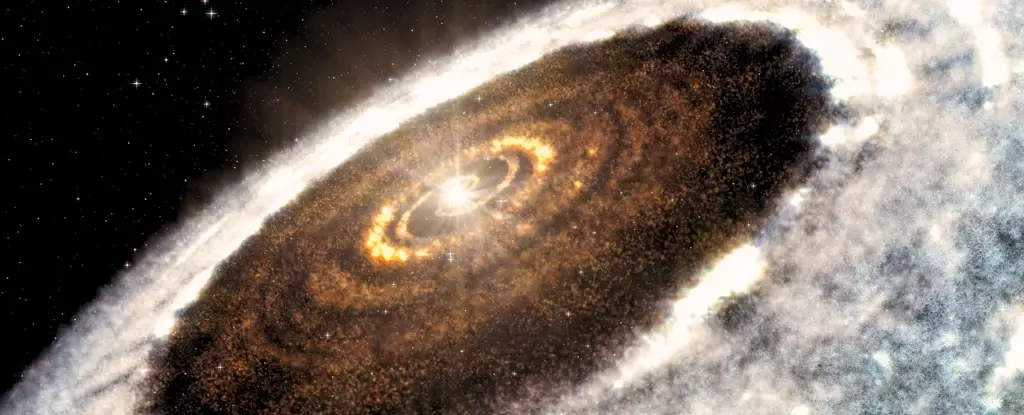Recent groundbreaking observations in astronomy have begun to challenge long-held assumptions about the origins of life. For decades, scientists believed that the formation of complex organic molecules was a process confined to planetary environments, occurring after planets had already formed or during their early development. Now, emerging evidence suggests that the seeds of life—molecules such as sugars and amino acids—may be sown much earlier, within the very fabric of the star-forming regions themselves. This shift in understanding not only illuminates how life might originate in distant worlds but also underscores the remarkable interconnectedness of cosmic processes.
The detection of molecules like glycolonitrile, a precursor to amino acids, and ethylene glycol, related to sugars, in the protoplanetary disks around young, forming stars suggests that the physical and chemical pathways leading to life are embedded in the universe’s earliest stages. This is a profound revelation, implying that the complex chemistry necessary for life is inherited by nascent planets rather than assembled later in their evolution. Such findings elevate the role of the vast, cold clouds of gas and dust—long considered merely the cradles of stars—to active chemical workshops where life’s essential molecules are crafted long before planetary systems take shape.
From Cosmic Dust to Building Blocks: The Journey of Organic Molecules
The process begins in the dense, cold molecular clouds scattered throughout galaxies. Within these regions, molecules gradually coalesce onto tiny ice grains, akin to cosmic snowballs coated with a chemical recipe. Under frigid conditions, these ice-coated grains act as chemical laboratories, facilitating reactions that produce increasingly complex organic compounds. The emerging evidence indicates that many of these molecules are not produced in isolation but are inherited from earlier interstellar phases, aligning with a continuous chemical evolution that stretches from the cloud to the star’s protoplanetary disk.
As the star begins to form, its rising heat sublimates the ice layers, releasing embedded molecules into the surrounding disk. This process effectively packages pre-made organics into the material that will eventually coalesce into planets, asteroids, and comets. The detection of these molecules, particularly in the tumultuous environment of a young, active star like V883 Orionis, demonstrates that complex chemistry endures through stellar infancy. It also underscores that these chemical precursors are resilient, capable of surviving the intense radiation and energetic phenomena associated with star formation.
However, the signals captured by current instruments like ALMA—though groundbreaking—are faint and require higher resolution and broader spectral analysis. This bottleneck highlights the necessity for advancing our observational capabilities to decode more intricate details of space chemistry. With improved technologies, scientists hope to uncover even more complex molecules, including those containing nitrogen, which are vital in constructing amino acids and nucleobases—the very foundation of life’s molecular machinery.
The Implications: Rethinking the Timeline of Life’s Emergence
This evolving understanding leads to a pivotal question: if the building blocks of life form in the cold depths of space and are integrated into planets during their birth, could life itself be a natural, inheritable trait of planetary systems? The idea that life’s necessary molecules are preloaded into planetary building blocks revolutionizes traditional concepts of abiogenesis—the process by which life arises spontaneously from non-living matter. It suggests a universe where life’s ingredients are not rare curiosities but common cosmic byproducts, waiting to be assembled under suitable conditions.
Furthermore, this research fosters optimism about the ubiquity of life in the universe. If complex organic molecules are widespread and incorporated into planets at their inception, then the probability of life existing beyond Earth increases dramatically. It transforms the narrative from one of unlikely chance to one of cosmic inevitability—a universe brimming with the potential for biological complexity. The fact that molecules similar to those that lead to life on Earth are observed in other stellar nurseries advocates for a universe where life’s molecular fingerprint is a natural and frequent outcome of star and planet formation.
Despite these exciting prospects, skepticism remains warranted. The journey from simple organic precursor to self-replicating, living systems is still shrouded in mystery. The presence of these molecules does not guarantee the emergence of life; it merely sets the stage. A critical downside of current investigations is that our understanding is incomplete, and technological limitations hinder definitive conclusions. Future missions and more sensitive instruments must expand our knowledge, providing clarity on how these molecules evolve and interact in the harsh realities of space.
In sum, the discovery of prebiotic molecules in star-forming regions challenges us to reconsider our conception of the universe—a cosmic nursery where the raw materials for life are woven into the fabric of star and planet formation. As our observational tools improve, so too will our appreciation for the universe’s capacity to seed life’s fundamental molecules across the cosmos, painting a picture of a universe inherently hospitable to life’s emergence.

